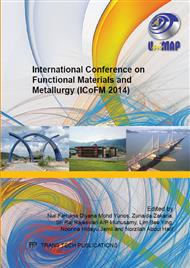[1]
A. G. MacDiarmid, A novel role for organic polymers, Angew. Chem. Int. Ed. 40, (2001) 2581-2590.
DOI: 10.1002/1521-3773(20010716)40:14<2581::aid-anie2581>3.0.co;2-2
Google Scholar
[2]
X. W. Li, X. H. Li, N. Dai, G. C. Wang, Z. Wang, Preparation and electrochemical capacitance performances of super-hydrophilic conducting polyaniline, J. Power. Sources. 195, (2010) 5417-5421.
DOI: 10.1016/j.jpowsour.2010.03.034
Google Scholar
[3]
M. Jiang, S. Zhu, Z. Zhou, A. Zhao, J. Lu, Effect of Ni2+ as a Codopant on the structure, morphology and conductivity of nanostructured polyaniline, J. Appl. Polym. Sci. 121, (2011) 3439-3445.
DOI: 10.1002/app.33867
Google Scholar
[4]
C. M. Yang, C. Y. Chen, Synthesis, characterisation and properties of polyanilines containing transition metal ions, Synth. Met. 153, (2005) 133.
DOI: 10.1016/j.synthmet.2005.07.136
Google Scholar
[5]
M. M. Rahman Khan, Y. K. Wee, W. A. K. Mahmood, Effects of CuO on the morphology and conducting properties of PANI nanofibers, Synth. Met. 162, (2012) 1065-1072.
DOI: 10.1016/j.synthmet.2012.07.006
Google Scholar
[6]
H. Xia, Q. Wang, Ultrasonic Irradiation: A novel approach to prepare conductive polyaniline/nanocrystalline titanium oxide composites, Chem. Mater. 14, (2002) 2158-2165.
DOI: 10.1021/cm0109591
Google Scholar
[7]
G. L. Teoh, K. Y. Liew, Wan A. K. Mahmood, Preparation of polyaniline-Al2O3 composites nanofibers with controllable conductivity, Mater. Lett. 61, (2007) 4947-4949.
DOI: 10.1016/j.matlet.2007.03.094
Google Scholar
[8]
N. N. Mallikarjuna, S. K. Manohar, P. V. Kulkarni, A. Venkataraman, T. M. Aminabhavi, Novel high dielectric constant nanocomposites of polyaniline dispersed with γ-Fe2O3 nanoparticles, J. Appl. Polym. Sci, 97, (2005) 1868-1874.
DOI: 10.1002/app.21405
Google Scholar
[9]
D. B. Mahesh, D. Raghunandan, S. Basavaraj, A. Venkataraman, Preparation and characterization of polyaniline-Co3O4 nanocomposites via interfacial polymerization, Am. J. Mater. Sci., 2, (2012) 39-43.
Google Scholar
[10]
Y.T. Ravikiran, M.T. Lagare, M. Sairam, N. N. Mallikarjuna, B. Sreedhar, S. Manohar, A.G. MacDiarmid T.M. Aminabhavi, Synthesis, characterization and low frequency AC conduction of polyaniline/niobium pentoxide composites, Synth. Met., 156, (2006).
DOI: 10.1016/j.synthmet.2006.10.002
Google Scholar
[11]
M. M. Rahman Khan, Y. K. Wee, and W. A. K. Mahmood, Synthesis of PANI-CaO composite nanofibers with controllable diameter and electrical conductivity, Polym. Compos. DOI 10. 1002/pc (2014).
DOI: 10.1002/pc.22950
Google Scholar
[12]
N. A. Surplice, The electrical conductivity of calcium and strontium oxides, British J. Appl. Phys. 17, (1966) 175-180.
DOI: 10.1088/0508-3443/17/2/303
Google Scholar
[13]
D. Tsotcheva, T. Tsanov, L. Terlemezyan, S. J. Vassilev, Structural investigations of polyaniline prepared in the presence of dodecylbenzenesulfonic acid, J. Therm. Anal. and Calor. 63, (2001) 133-141.
DOI: 10.1023/a:1010140504579
Google Scholar
[14]
M. T. Cortes, E. V. Sierra, Effect of synthesis parameters in polyaniline: influence on yield and thermal behavior, Polym. Bullet. 56, (2006) 37-45.
Google Scholar
[15]
R. Ansari, M. B. Keivani, Polyaniline conducting electroactive polymers: thermal and environmental stability studies, E-J. Chem. 3, (2006) 202-217.
DOI: 10.1155/2006/395391
Google Scholar
[16]
S. Wang, Z. Tan, Y. Li, L. Sun, T. Zhang, Synthesis, characterization and thermal analysis of polyaniline/ZrO2 composites, Thermichimica Acta. 441, (2006) 191-194.
DOI: 10.1016/j.tca.2005.05.020
Google Scholar
[17]
A. H. Gemeay, R. G. El-Sharkawy, I. A. Mansour, A. B. Zaki, Preparation and characterization of polyaniline/manganese dioxide composites and their catalytic activity, J. Coll. Interf. Sci. 308, (2007) 385-394.
DOI: 10.1016/j.jcis.2006.12.077
Google Scholar


